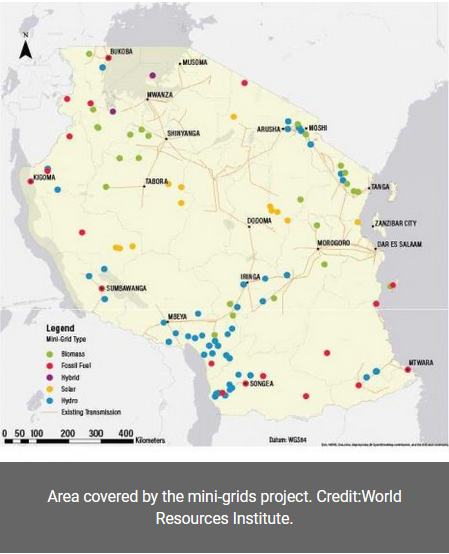The expansion of mini-grids in Tanzania, enabled by bold and adaptive energy policies, is bridging the gap for the population lacking access to electricity.
A South African-based energy news outlet says the solution to Tanzania’s lack of electricity in rural areas may be found in ‘mini-grids’. That view is according to a new report compiled by the Tanzania Traditional Energy Development Organisation (TaTEDO) and World Resources Institute (WRI), which highlights that more than 70% of the population still lack access to electricity.
Esi-Africa.com says the TATEDO/WRI report, Accelerating Mini-grid Deployment in Sub-Saharan Africa: Lessons from Tanzania, was released on Wednesday [October 4, 2017] in Dar es Salaam.
Regional leader in mini-grids
The report has found that Tanzania now has 109 mini-grids, serving over 180,000 people. The country’s mini-grids’ 157.7MW of installed capacity consists of; hydro, biomass, hybrid, fossil fuel and solar systems.
By comparison, Tanzania’s central grid has an installed generation capacity of approximately 1,500MW, with mostly hydro and natural gas, serving around 9 million people.
Commenting about the report, Deputy Minister for energy and minerals, Dr. Medard Kalemani, said: “Given the challenges of insufficient electricity and difficulties for the national grid to reach all areas in the country, it is essential to develop mini-grids, micro-grids and stand-alone electrification.”
Kalemani continued: “As a country, we are committed in promoting renewable energy technologies by making sure that proper frameworks and other enabling environments are in place to facilitate investments. Off-grid electrification using renewable energy technologies can offer a power solution to rural and remote areas.
“Tanzania is committed to implementing Sustainable Development Goal 7 that by 2030 will ensure most of the population access to modern energy services and will double the share of renewable energy in the energy mix.”
According to the study, by 2040, an estimated 140 million rural Africans will get electricity from mini-grids, requiring more than 100,000 mini-grids to be built.
Rural electrification
Rural electrification is said to be a key component of the government’s plan to make Tanzania a middle-income country by 2025. Given the country’s large size and low rural population density extension of the national grid to many isolated rural areas is not economically feasible.
The report noted that government estimates that about half the rural population may be more cost-effectively served by decentralised options than by centralised grid expansion. Read more…
“We’ve long heard that Tanzania is a regional leader in mini-grid development. Our research establishes the fact,” said Estomih Sawe, executive director, TaTEDO.
“As we collected data for this report, we saw how mini-grids can support schools, health clinics and small businesses in Tanzania’s rural communities. We need more information about how mini-grid development can help households across Tanzania.”
Low-cost investment
In 2008, Tanzania adopted a new regulatory framework to encourage low-cost investment in mini-grids, called the small power producers (SPP) framework, which resulted in the number of mini-grids doubling.
The financial mechanism created – a feed-in tariff – was technology neutral, which favoured biomass and hydro development. However, a 2015 revision to the policy encouraged solar and wind development.
Furthermore, in June this year, the Energy and Water Utilities Regulatory Authority (EWURA), approved a third generation mini-grid framework.
The third generation rules provide several important improvements to create an enabling regulatory environment, including:
- Allowing mini-grids at multiple locations to acquire a single license (above 1MW) or registration for mini-grids using the same technology (below 1 MW);
- Defining eligible customers that need not have their tariffs reviewed by EWURA; providing for provisional registrations for mini-grids;
- Allowing grid-connected mini-grids to operate in islanded mode when power supply is not available from the main grid;
- And providing additional clarity and credibility on the calculation of compensation for distribution assets when the main grid connects to a previously isolated mini-grid.
EWURA director of electricity, Eng. Godfrey H. Chibulunje, said: “The third generation SPP and mini-grid rules represent a significant next step in our continued efforts to create an enabling environment for mini grids in Tanzania.”
“With explicit guidance on options for when the main grid arrives and a simplification of the licensing and registration requirements, among other important updates, we are confident that these new rules will encourage even more investment in mini-grids over the next several years,” Chibulunje added. Download the full report here Source: Esi-Africa





